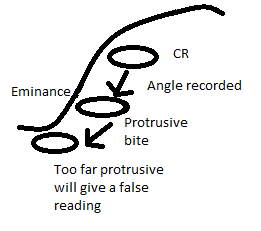The protrusive bite
In complex rehabilitations cases, the more records that you collect often results in less adjustments on insert. Multiple unis prosthodontics removes the stability of the casts on mounting therefore the bite record is paramount. The protrusive bite becomes necessary to program the condylar angle on a semi adjustable articulator. One of many variations in human anatomy, the condylar angle has implications for guidance of the mandbible in protrusion and laterotrusion from CR. It represents the steepness of the articular eminence that the condyle translates down (Figure 1). Steep condylar angles will result in rapid disclusion of the dentition from CR whereas shallow condylar angles will have quite subtle disclusion.
The protrusive bite is only valid to program the articulator if the maxillary cast was mounted with a facebow as the measurement relies on the maxilla being properly oriented to the TMJs. The bite registration does not have to be taken in centric relation as long as the maxillary cast is mounted correctly. This is because a static bite will correctly orient the mandibular case in a true representation to the TMJs. Therefore the protrusive bite will still be valid. Steep condylar eminences allow steeper cusp designs and anterior guidance as the movements of the joints will allow disclusion of these teeth before any interferences occur.Conversely, shallow eminentia requires very flat cusps and a non locked-in occlusion as more stress will be placed on the teeth in protrusion and laterotrusion.
The maxillary cast will be mounted with the face bow, the mandibular case with the bite registration (static or CR). The condylar angles will then be unlocked and the protrusive bite placed in. The technician will manipulate the articulator until the casts fit the bite and then lock the condylar angles into place. This customised record removes the use of average angles which are rarely appropriate. The protrusive bite should be taken with the patient protruding 4-5mm anteriorly. A leaf gauge can be used to avoid posterior interferences on protrusion. You must avoid allowing the patient to protrude too far forwards as it will cause a false reading of the condylar angle as the condyle comes over the articular eminence (Figure 1).
The condylar angle is not a visible phenomenon until it is programmed onto the articulator. It has important implications on the design of cusps and anterior guidance in full arch cases and is an important record to gather in these cases to reduce the need for adjustments in the insert appointment
The protrusive bite is only valid to program the articulator if the maxillary cast was mounted with a facebow as the measurement relies on the maxilla being properly oriented to the TMJs. The bite registration does not have to be taken in centric relation as long as the maxillary cast is mounted correctly. This is because a static bite will correctly orient the mandibular case in a true representation to the TMJs. Therefore the protrusive bite will still be valid. Steep condylar eminences allow steeper cusp designs and anterior guidance as the movements of the joints will allow disclusion of these teeth before any interferences occur.Conversely, shallow eminentia requires very flat cusps and a non locked-in occlusion as more stress will be placed on the teeth in protrusion and laterotrusion.
The maxillary cast will be mounted with the face bow, the mandibular case with the bite registration (static or CR). The condylar angles will then be unlocked and the protrusive bite placed in. The technician will manipulate the articulator until the casts fit the bite and then lock the condylar angles into place. This customised record removes the use of average angles which are rarely appropriate. The protrusive bite should be taken with the patient protruding 4-5mm anteriorly. A leaf gauge can be used to avoid posterior interferences on protrusion. You must avoid allowing the patient to protrude too far forwards as it will cause a false reading of the condylar angle as the condyle comes over the articular eminence (Figure 1).
The condylar angle is not a visible phenomenon until it is programmed onto the articulator. It has important implications on the design of cusps and anterior guidance in full arch cases and is an important record to gather in these cases to reduce the need for adjustments in the insert appointment

If you mount the mandibular cast in a static bite, don't you risk the jaw going to CR once you have removed the centric stops with the consequence being your final restorations not occluding properly?
ReplyDeleteHi DKT, Thanks for your question.
ReplyDeleteThis is a risk with any restorative work in any occlusion. The habitual bite is forward of CR in the majority of people and the majority of people function fine.
One role of the temporary stage is diagnostic and reviewing the patient and grinding their temporaries in till they are functional will allow you to gauge your chance of success. You must ensure that you are happy that their bite is functional and reproducible before you progress to the final stage. If every time they come back for a review the occlusion has shifted, most likely they are moving back into CR and the temporaries are acting as a sort of deprogrammer. Once you have produced stable occlusal contacts they are likely to be in CR anyway by that point.
The logic follows that if they were deviant from CR preoperatively and could tolerate it then they are likely to be able to do so post operatively. The static bite registration is used when you are happy with the occlusion of your temporaries in terms of OVD, AP position and occlusal contacts and want to reproduce them in the final. This implies you have had an appropriate trial period with temporaries and are satisfied that the bite will be stable before proceeding to finish the case.